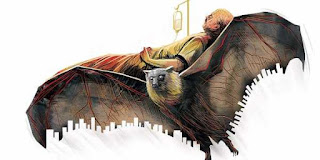The deadly virus named Nipah has struck over the state of Kerala and is taking away lives of many people. Till now the death toll has risen to ten and more than 25 persons have been hospitalised with fever and suspected symptoms of encephalitis associated with Nipah virus. The virus is spreading very fast and soon it will also be taking the other parts of the country in its grip. So one needs to be very careful and should have an understanding what exactly the Nipah virus is, what are its symptoms and what precautions one have to take.
What is Nipah Virus ?
Nipah Virus was first observed in Malaysia and Singapore in 1998 and 1999. It first appeared in domestic pigs and has been found among several species of domestic animals including dogs, cats, goats, horses and sheep. It is a Zoonosis, means it affects both animals and humans. The natural host of the virus are fruit bats of the Pteropodidae Family, Pteropus genus. It has got its name from the village Sungai Nipah in Malaysia where it was first reported when farmers working with the pigs got infected from it. In India it was first reported in 2001 and then in 2007. Seventy-one cases with 50 deaths were reported during the two outbreaks. Both the times, the disease was reported in areas of West Bengal bordering Bangladesh
What are the Symptoms of Nipah virus and how it spreads?
The infection presents as an encephalitic syndrome marked by fever, headache, drowsiness, disorientation, mental confusion, coma, and potentially death. The virus can be transferred from a human through close contact, body fluids, saliva and cough.
It can be transmitted via direct or indirect contact with host animals (generally fruit bats or pigs) or via contact with other Nipah virus-infected persons. Doctors say fruit bats are the carriers of the virus and humans consuming fruits or vegetable half-eaten by the fruit bats could lead to spread of the virus.
Precautionary Measures
There is no proven vaccine. Nipah is treated with intensive care and can be controlled from spreading.The farm animal should be prevented from eating fruit contaminated by bats as they are the main cause of infection.
Medical officials who are looking after the patients with suspected or confirmed NiV should take basic precautions like washing hands, using a gown, cap mask and wearing gloves. For laboratory personnel, Nipah virus is classified internationally as a biosecurity level (BSL) 4 agent. BSL 2 facilities are sufficient if the virus can be first inactivated during specimen collection.
In case of animals, wire screens can help prevent contact with bats when pigs are raised in open-sided pig sheds. Run-off from the roof should be prevented from entering pig pens. Early recognition of infected pigs can help protect other animals and humans. Due to the highly contagious nature of the virus in swine populations, mass culling of seropositive animals may be necessary.
Nipah outbreaks mostly between December and May but has shown itself to have a relatively high mortality rate. Morbidity and mortality rates due to Nipah or Nipah-like virus encephalitis, South-East Asia Region, 2001-2012. (Source: WHO/South East Asia)
Source: Rapublicworld







No comments:
Post a Comment